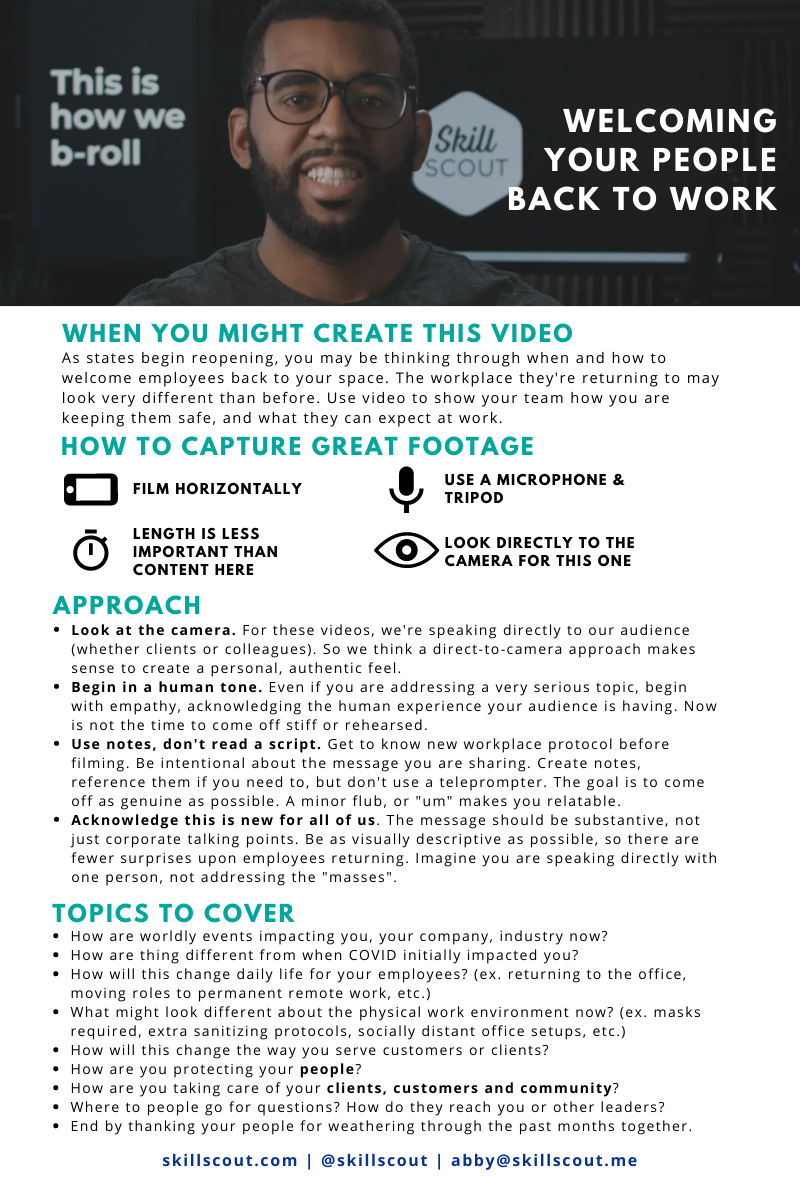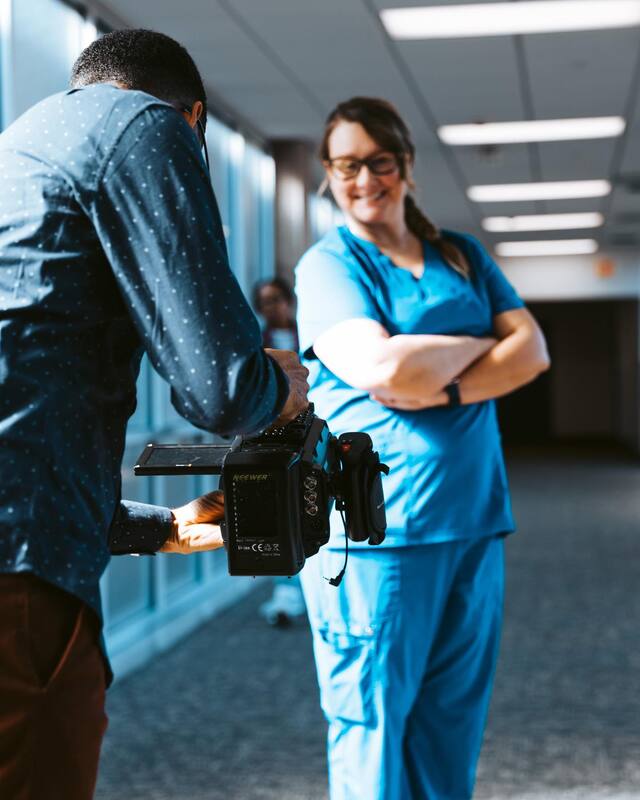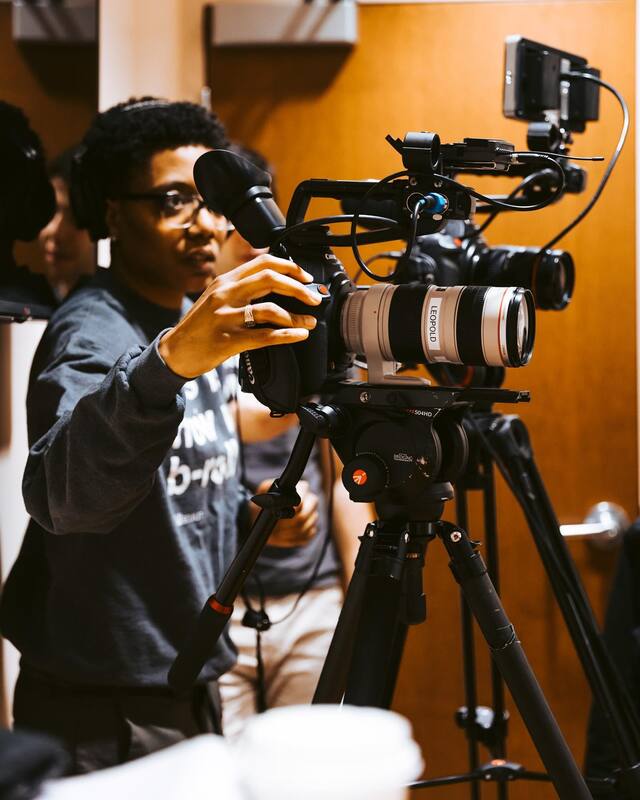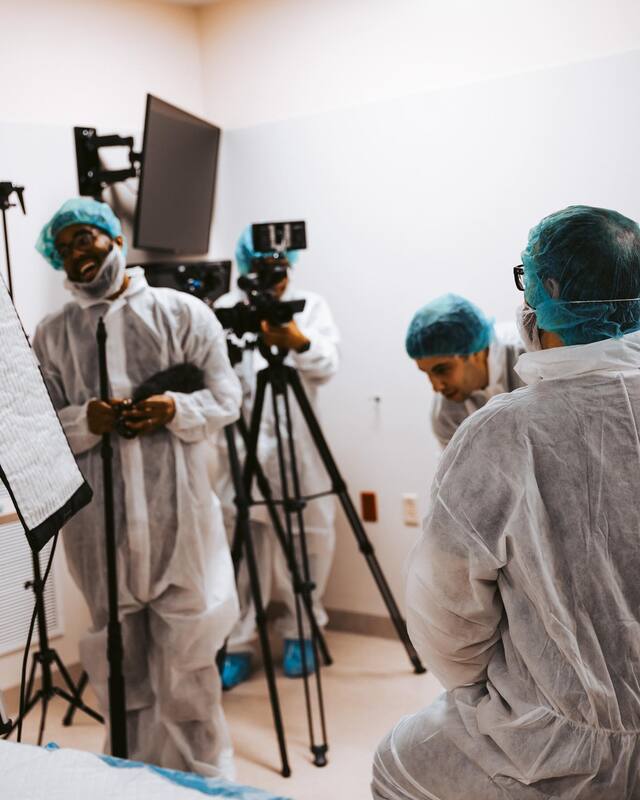|
Author: Nate Brown | Chief Creative Officer
What are your team's biggest questions?
We've been through a whirlwind few months as humans, colleagues, business leaders. I'm speaking collectively, because I bet you may be feeling the same way! Through it all, we've been communicating, easing fears, answering questions and charting the future. How about you?
Speaking of charting the future, as states begin reopening, you may be thinking through when and how to welcome employees back to your space. Whether your workforce went all virtual, or remained open as an essential service, the workplace today looks very different than before. As you ease your team into the next phase of reopening -- whatever that may be for your company, consider using video to show your team how you are keeping them safe, and what they can expect at work. Start by answering your team's biggest questions. For our team, it was questions around how do we get back to filming workplace stories, in a safe and socially distant manner. How do we protect our clients, and our team? To address this, we carefully followed the film industry protocols, and developed a plan. I created this video to provide an overview of changes to our production process, and welcome our team back to filming. Use this recipe to create your own communication plan!
0 Comments
Author: Abby Cheesman | Co-Founder
Video is a powerful way to connect and share the stories of humanity that make up your company.
And, it’s the hottest thing on the inter-webs -- by next year, about 70% of mobile traffic will be video. If you don't have a film producer on your team, or your video projects get put on the back burner with your corporate communications team, you may find yourself looking for outside help. But, how do you find the right partner to create your workplace videos? A question to ask yourself:
The good news is, you’ve got options! Finding the right partner is a matter of your budget, goals, visual style and identifying a team that is up to the task of creating a genuine glimpse inside of your company.
Aside from the obvious (gathering portfolio of their work, and ballpark pricing), we’ve put together a list of questions you might find helpful as you pick the right video partner for your team. 1. Can you walk me through your creative process?
Video can feel like a big undertaking: expensive, stressful and highly visible. If it’s your first go around, you probably have questions. Who do we ask to interview? Is this a good video background? How do I get my people comfortable to participate? How do we stay within my budget?
A good video partner has planned, filmed and edited videos inside of a company before. They should have a process. Ask them what materials they provide to help you align on video goals, storyboard, establish a visual treatment and create a field guide for filming. You should expect a video company to take the lead on most or all of these items. You’ll take a lead on identifying people to feature, booking a space at your location to film, and invite the key players to sign off on the plan. In post-production, you want to understand how stories are identified and which clips make it into the final cut. What opportunities do you have to weigh in on this? You should also gauge how flexible their process is if you envision something that pushes creative boundaries...like filming an overnight truck driver during their actual shift at 3am. 2. Who owns our video footage?
This is a big one. Many video companies hold rights to your footage so you continue working with them, and/or require you to purchase the raw footage at an additional fee. Having a production company own your footage can be a big issue, especially if future creative, budgetary, or personality differences get in the way of your collaboration. Not only that, the raw footage is a gold mine of stories and visuals that never gets used. If you want the footage you pay your video partner to capture to be yours forever, make sure this is in your agreement. That goes for transcripts of all of your interviews, too. If you own your content, you can use it to create additional videos, make social media content, share with your friends in marketing, grab screen shots for a presentation, or force your family to watch with you on the weekends. Whatever fits your fancy.
3. How have you handled challenges specific to our industry?
Every workplace has constraints and considerations for filming. Your goal for workplace video is to create a genuine piece of content that’s captured in a way that honors people, privacy and safety. At the same time, you want to capture human stories that are visually beautiful and compelling. Ask your video partner how they plan for success in your environment.
If you are in healthcare, ask about how they handle capturing patient scenarios. For example, our team recruits stand-ins to play the role of patients so we can capture footage of nurses taking vitals or administering medicine without violating the privacy of real patients. In heavily regulated industries like aerospace or banking, we ask to have a compliance leader join us for planning and during filming. Your video partner should walk you through scenarios they’ve encountered in your industry to create a human-centered plan for filming. 4. Is editing automated with technology, or is there a human editor?
There are a number of video solutions to capture, share and publish workplace videos (which is awesome!). Some offer full production, some offer lightweight automated solutions. Understanding how video clips are captured and edited will be the key to figuring out which partner best fits your needs and budget.
Are you creating realistic job previews? Employee stories that help candidates see your values in action? Or maybe you’re in the market for quick social media or hiring manager videos. For the latter, you may want to film your own clips and submit them to a tech platform for editing. This works well for high volume videos, where you don’t need a lot of creative consultation. You may need guidance on putting together stories, capturing footage, and creating a compelling piece of content. Find out how this works with the partner you’re talking to. You may find that working with more than one video partner helps solve many of your content needs (lots of our clients do this, to great success!). 5. How do you incorporate our brand in videos?
Some companies have a very strong marketing brand and presence. Your marketing colleagues will probably have opinions on how the brand is visually represented. If you haven't thought to do so already, a good video partner will ask to involve your marketing colleagues early and often to ensure the video is 110% ready for airplay once you're finished. Ask your video partner how they plan to incorporate your brand into your videos. If you have video “bumpers” or treatments, your video partner should be willing to use those. If you don’t have assets available, ask your video partner if they’d be willing to create treatment for you that's in line with your brand. Send any existing videos that you’re trying to match style to the video team ahead of filming so they know exactly what you mean when you talk about that animated logo thingy at the end.
6. Tell me about your team. Who will film and edit?
If you want to tell diverse stories about your workplace, the best way to do that is through a diverse group of storytellers. Your video partner should be able to share the makeup of their team with you. Representation matters, so look for a team that reflects the diversity at your company, and the people you want to engage. You also want to understand everyone’s role during pre-production, filming and post-production so you can direct questions and feedback.
7. Walk me through a typical film day. What can I expect?
Film days are like birthday parties. Or weddings. Lots of planning and build up. Spending money, and keeping to a budget. A ton of moving parts, usually something unexpected, and typically a ton of fun.
Ask how a film day is structured: who shows up from the film team, their roles, who can help make decisions on the fly. This will help you figure out your team’s role and who may need to participate from your end. Gauge the video partner's flexibility if things don’t go as planned. Is it a team who needs a rigid structure to achieve your film goals? How realistically will a schedule play out in your own company? Do people come to meetings on time? Do you work in an industry like aviation, healthcare or customer service where the day often has unexpected changes? Your video partner should help you build a schedule that allows for flexibility you might need, but also captures the variety of footage needed for your videos. Lean on them to build the schedule, and you fill in any relevant details about your work schedules, customer busy times, or breaks! 8. How do you make people feel comfortable on camera?
The difference between a decent and a great video partner is the experience they create for your team as they capture your stories. Work is personal. Some of the best interviews get emotional. Filming can make even the most confident employee feel vulnerable or awkward.
Workplace video is NOT like filming a commercial. There are no actors or scripts here. So it is important to communicate what this video is about, who it's for, and why you are asking your colleagues to appear on camera. Once your people are in front of the camera, you want a producer who puts them at ease. A great producer designs an experience to help employees feel celebrated and prepared for filming. They should offer to get in touch with your employees ahead of filming to get to know each other, walk through what to expect, and answer questions your film star might have. There are lots of ways to create employee stories on camera. My team and I are advocates of an ethnographic interview style, where we use a discussion guide, not a script. We leave space for discovery in our time with your featured employees. Ask your prospective partner how they do it, and pick a style that will make your colleagues most comfortable to share freely. 9. How do we review our video? How many edit cycles are included?
In the game of video review, there are lots of cooks in the kitchen. Legal, Marketing, Compliance probably all need to weigh in. Collecting, organizing, and interpreting feedback can be a huge headache. Find out what processes or tools your video partner uses to make it easy on you.
Find out how many rounds of edits you get before you get charged for them. We’ve found that for most corporate clients, 2 rounds of edits after the initial draft is the right amount. If you have lots of stakeholders, or an intensive legal review process, you might need 3-4. Find out up front what is included, and an estimated range of what additional revisions look like. 10. What language(s) does your film and editing team speak?
If you are a global company, or have candidates who may have a better experience viewing your content in their native language, this is a good time to ask your video partner about their language and translation capabilities. This will all come down to your needs. For example, a U.S. based company with locations in Latin America may prefer English and Spanish for interviews, and foreign language subtitles in Portugese. Fun fact - the most language translations we’ve created for one video was 13 -- for a global company hiring similar roles across the world.
11. How do you handle captions or subtitles?
Did you know a whopping 85% of videos on Facebook are watched without sound? I could go on all day about the virtues of captioning your video. Great video partners can help generate caption files, create foreign language subtitles, or burn captions into your video. Ask what’s included in the price, and evaluate whether you might need translations.
|
Skill Scout TeamEverything film, storytelling and human-centered workplace coming at you from Elena, Abby, and our brilliant teammates. Archives
June 2020
Categories |
||||||





 RSS Feed
RSS Feed